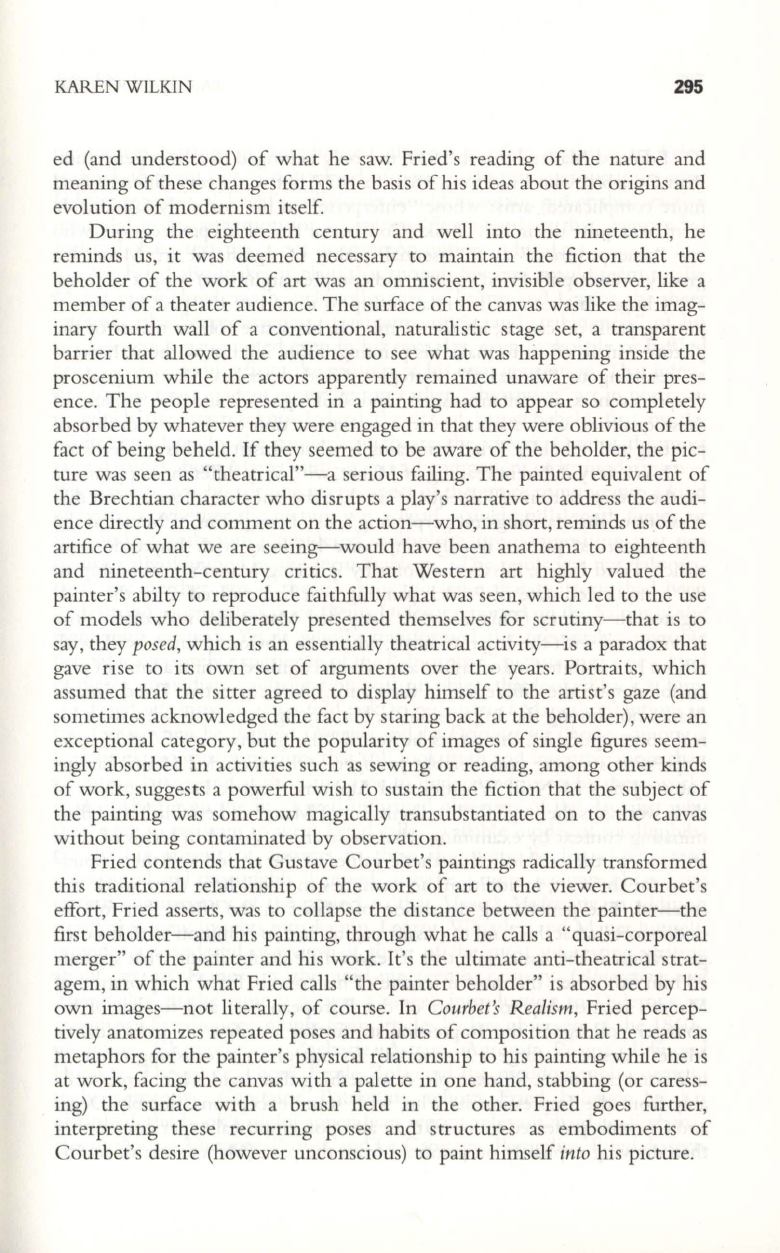
KAREN WILKIN
295
ed (and understood) of what he saw. Fried's reading of the nature and
meaning of these changes forms the basis of his ideas about the origins and
evolution of modernism itself.
During the eighteenth century and well into the nineteenth, he
reminds us, it was deemed necessary to maintain the fiction that the
beholder of the work of art was an omniscient, invisible observer, like a
member of a theater audience. The surface of the canvas was like the imag–
inary fourth wall of a conventional, naturalistic stage set, a transparent
barrier that allowed the audience to see what was happening inside the
proscenium while the actors apparently remained unaware of their pres–
ence. The people represented in a painting had to appear so completely
absorbed by whatever they were engaged in that they were oblivious of the
fact of being beheld. If they seemed to be aware of the beholder, the pic–
ture was seen as "theatrical"-a serious failing. The painted equivalent of
the Brechtian character who disrupts a play's narrative to address the audi–
ence directly and comment on the action-who, in short, reminds us of the
artifice of what we are seeing-would have been anathema to eighteenth
and nineteenth-century critics. That Western art highly valued the
painter's abilty to reproduce faithfully what was seen, which led to the use
of models who deliberately presented themselves for scrutiny-that is to
say, they
posed,
which is an essentially theatrical activity-is a paradox that
gave rise to its own set of arguments over the years. Portraits, which
assumed that the sitter agreed to display himself to the artist's gaze (and
sometimes acknowledged the fact by staring back at the beholder), were an
exceptional category, but the popularity of images of single figures seem–
ingly absorbed in activities such as sewing or reading, among other kinds
of work, suggests a powerful wish to sustain the fiction that the subject of
the painting was somehow magically transubstantiated on to the canvas
without being contaminated by observation.
Fried contends that Gustave Courbet's paintings radically transformed
this traditional relationship of the work of art to the viewer. Courbet's
effort, Fried asserts, was to collapse the distance between the painter-the
first beholder-and his painting, through what he calls a "quasi-corporeal
merger" of the painter and his work. It's the ultimate anti-theatrical strat–
agem, in which what Fried calls "the painter beholder" is absorbed by his
own images-not literally, of course. In
Courbet 's Realism,
Fried percep–
tively anatomizes repeated poses and habits of composition that he reads as
metaphors for the painter's physical relationship to his painting while he is
at work, facing the canvas with a palette in one hand, stabbing (or caress–
ing) the surface with a brush held in the other. Fried goes further,
interpreting these recurring poses and structures as embodiments of
Courbet's desire (however unconscious) to paint himself
into
his picture.


